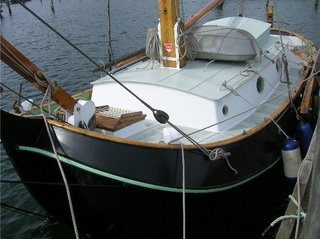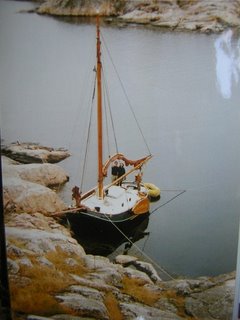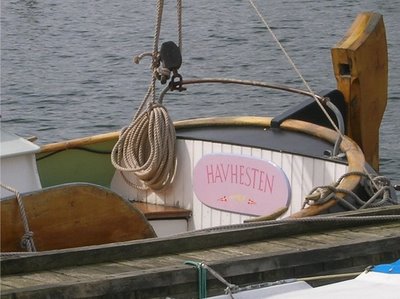Havhesten...
 At this point it had been almost four months since I had gone sailing and I was beginning to show symptoms of severe withdrawl--that unique kind of inverse scurvy that passionate sailors suffer on shore. Ole had it too, and as Easter weekend marks the start of the vessel repair and outfitting season in Scandinavia, we soon headed for the little harbor where Ole moors his precious little boat, Havhesten. She was a cute little craft, 7 meters long at the waterline, but plump enough to make up for her lack of length. She was custom built for Ole in 1990 and has a steel hull, but her design is traditionally Danish from stem to stern; the lee boards, the retractable bowsprit, the bowed gaff, the double-ended hull, the tall rudderpost, and the 'Popeye's-chin' bow shape.
At this point it had been almost four months since I had gone sailing and I was beginning to show symptoms of severe withdrawl--that unique kind of inverse scurvy that passionate sailors suffer on shore. Ole had it too, and as Easter weekend marks the start of the vessel repair and outfitting season in Scandinavia, we soon headed for the little harbor where Ole moors his precious little boat, Havhesten. She was a cute little craft, 7 meters long at the waterline, but plump enough to make up for her lack of length. She was custom built for Ole in 1990 and has a steel hull, but her design is traditionally Danish from stem to stern; the lee boards, the retractable bowsprit, the bowed gaff, the double-ended hull, the tall rudderpost, and the 'Popeye's-chin' bow shape.
So, as politely as I could, I asked Ole if Havhesten was indeed named after the cute little horse-head shaped fish that nestles in the seagrass.

Well, this is 'a sea horse' according to the Danes. We english speakers would call it a baby 'fulmar', a species of tubenose gull like an albatross but with decently proportioned wings...unlike an albatross.
Ole explained to me that these havhests or fulmars lay their eggs on the steep cliffs of the Farao Islands (you may recall my story-telling blog when Ole recounted the Farao Islanders' egg-hunts). When they hatch, adult birds spend all their time delivering fatty, oily fish to the chicks, fattening them up for the cold waters and the approaching winter. After a few weeks the not-so-little chicks are ready to branch out and explore the world around them. Rolling in fat, they waddle out of the nest and quite confidently spread their little wings and step off the ledge...and fall like fat little water balloons all the way down to the sea below, still flapping enthusiastically (the recent film "Winged Migration" has a beautiful clip of this). After the ensuing splash, off they go--well insulated and ready to slim down and get some real feathers. The Farao Islanders call these obeice little hatchlings "havhester" in refernce to the more standardized Danish term "flodheste" meaning 'river horse'... actually a hippopotamus (wait, but that was the latin name for....). With any luck, by fall the fat little things should be flying.
So how did Ole's boat get named after such a hopelessly overweight creature?
 Well, just look at the hull shape of this little thing!
Well, just look at the hull shape of this little thing!
But very quickly I could see she was a fine little vessel--and given that tubby shape, she was certainly going to be stable in any kind of sea.
 Like the other boats at the marina, Havhesten had also been in winter hibernation for many months and needed us to check her over thoroughly and begin the annual task of spring maintenance; cleaning, sanding, varnishing, and painting. So, as I started to swab the decks and clean off the dirt and moss sprouts, Ole began opening hatches and rummaging around sorting through various chandlery items left aboard. He was delighted to find a forgotten bag of linden bast for making rope!
Like the other boats at the marina, Havhesten had also been in winter hibernation for many months and needed us to check her over thoroughly and begin the annual task of spring maintenance; cleaning, sanding, varnishing, and painting. So, as I started to swab the decks and clean off the dirt and moss sprouts, Ole began opening hatches and rummaging around sorting through various chandlery items left aboard. He was delighted to find a forgotten bag of linden bast for making rope!  Then came the inevitable question of whether or not the engine was interested in serving another season. After checking the batteries and enticing the engine with some fresh oil, Ole turned the key and the little diesel jumped to life and sat there eagerly puttering away. The smoke hadn't even cleared before I was eyeing the winds over the channel, wondering if it would be worth puttering out of the harbor.
Then came the inevitable question of whether or not the engine was interested in serving another season. After checking the batteries and enticing the engine with some fresh oil, Ole turned the key and the little diesel jumped to life and sat there eagerly puttering away. The smoke hadn't even cleared before I was eyeing the winds over the channel, wondering if it would be worth puttering out of the harbor. Next Ole and Mads and I set to work hauling out the sails and preparing them to be bent on the rig. They were lovely red cloth (Dacron, yes, but it was hard to tell) and upon seeing them, I could hardly wait to see Havhesten under way.
Next Ole and Mads and I set to work hauling out the sails and preparing them to be bent on the rig. They were lovely red cloth (Dacron, yes, but it was hard to tell) and upon seeing them, I could hardly wait to see Havhesten under way. Meanwhile, Annette was converting the cabin from a winter storage locker back into a habitable space...
Meanwhile, Annette was converting the cabin from a winter storage locker back into a habitable space... ...and putting a pot of tea on the stove to fend us off from the biting spring wind.
...and putting a pot of tea on the stove to fend us off from the biting spring wind. When things were more or less shipshape on deck, tea time was called and I got a peek into the cabin, no longer heaped with sails and spars--well, the gaff and tiller were still lying on the bunk. Nice place! I could spend a summer here....
When things were more or less shipshape on deck, tea time was called and I got a peek into the cabin, no longer heaped with sails and spars--well, the gaff and tiller were still lying on the bunk. Nice place! I could spend a summer here.......but, with the day's work deemed satisfactorily finished and pressed by the need to make Easter preparations for the anticipated 'army' of toddlers on the way, we departed the boatyard.
 That night as we readied the house to 'billet the troops' due to arrive the next day, Ole told me many tales about the great trips he and Annette have taken in Havhesten, ranging from Århus harbor to Marstrand and Kyrkesund in Sweden and from the open Baltic to the narrow marsh channels of lowland Denmark. This was a photo he showed me from the Swedish coast. Because there is no tide in the Baltic once you round the north end of Denmark, it is safe to pull the boat right up to the shore like this--especially Havhesten because she only draws 60cm of water.
That night as we readied the house to 'billet the troops' due to arrive the next day, Ole told me many tales about the great trips he and Annette have taken in Havhesten, ranging from Århus harbor to Marstrand and Kyrkesund in Sweden and from the open Baltic to the narrow marsh channels of lowland Denmark. This was a photo he showed me from the Swedish coast. Because there is no tide in the Baltic once you round the north end of Denmark, it is safe to pull the boat right up to the shore like this--especially Havhesten because she only draws 60cm of water. A few days later, after having survived a wonderful all-day Easter seige with 'the troops', Ole and I returned to Havhesten with the intention of taking her out for the first shakedown cruise of the season. Dressed in all our heavy layers, we came down the dock, fired up the engine, and cast off the lines. Gliding that bulbous hull over the surface like a curled maple leaf, we skirted the docks and made for the harbor channel.
A few days later, after having survived a wonderful all-day Easter seige with 'the troops', Ole and I returned to Havhesten with the intention of taking her out for the first shakedown cruise of the season. Dressed in all our heavy layers, we came down the dock, fired up the engine, and cast off the lines. Gliding that bulbous hull over the surface like a curled maple leaf, we skirted the docks and made for the harbor channel. Rounding the light at the end of the breakwater, I went forward, lowered the bowsprit and lashed it down, and then began to hank on the jib and rig the sheets.
Rounding the light at the end of the breakwater, I went forward, lowered the bowsprit and lashed it down, and then began to hank on the jib and rig the sheets. Then Ole handed the helm over to me while he wrestled with the lee boards and grumbled over the seaweed and barnacles on the hull and prop that were slowing us down. There was a strong southeasterly blowing and even before we raised sail I could feel my 'inverse scurvy' clearing up.
Then Ole handed the helm over to me while he wrestled with the lee boards and grumbled over the seaweed and barnacles on the hull and prop that were slowing us down. There was a strong southeasterly blowing and even before we raised sail I could feel my 'inverse scurvy' clearing up. Not far beyond the harbor, we turned into the wind to see if we could work our way back against it. It was mighty slow going. The not-so-little engine cranked out a whopping 27hp--quite a bit for a boat this size--but the prop and hull were too fouled with growth from a winter at the dock to permit much headway so Ole and I decided to play it safe and sail upwind first.
Not far beyond the harbor, we turned into the wind to see if we could work our way back against it. It was mighty slow going. The not-so-little engine cranked out a whopping 27hp--quite a bit for a boat this size--but the prop and hull were too fouled with growth from a winter at the dock to permit much headway so Ole and I decided to play it safe and sail upwind first. We set the jib and boy, was it a sight! That big red sail ballooning out in the stiff breeze...
We set the jib and boy, was it a sight! That big red sail ballooning out in the stiff breeze...And the motion! I love the motion of a boat under sail! I was in heaven... and my 'scurvy' was cured almost in an instant.
 Sadly, we had to beat to windward under the jib alone. As Ole intended to haul the boat out in a week or two and pull the mast, bending on the mailsail was a hassle not worth dealing with. Naturally, without the main, going to windward was a bit...well, a bit of a challenge. We mostly just scooted sideways along the surface, steadily losing windward ground as we crossed the channel. But, despite our disconcerting amount of leeway, we were having a grand time just being out on the water again for the first time this season.
Sadly, we had to beat to windward under the jib alone. As Ole intended to haul the boat out in a week or two and pull the mast, bending on the mailsail was a hassle not worth dealing with. Naturally, without the main, going to windward was a bit...well, a bit of a challenge. We mostly just scooted sideways along the surface, steadily losing windward ground as we crossed the channel. But, despite our disconcerting amount of leeway, we were having a grand time just being out on the water again for the first time this season. The wind was blowing hard enough that we were able to keep up a fine pace of about 5 knots the whole time, plowing up a frothing bowwave from our blunt bow and leaving a churning wake astern.
The wind was blowing hard enough that we were able to keep up a fine pace of about 5 knots the whole time, plowing up a frothing bowwave from our blunt bow and leaving a churning wake astern. After a bit I handed the tiller back to Ole so I could take a minute to enjoy my old pass-time of standing on the cabin top beside the mast, clutching the shrouds and riding that bucking...havhest...across the bay like Admiral Farragut himself.
After a bit I handed the tiller back to Ole so I could take a minute to enjoy my old pass-time of standing on the cabin top beside the mast, clutching the shrouds and riding that bucking...havhest...across the bay like Admiral Farragut himself.  There is no finer feeling than that; being braced there in the blasting wind between the mast and rigging right over the boat's fulcrum, feeling every motion of the vessel as if it were your own, absorbing the tension of the quivvering sails, and surveying a grand vista of ship, spray, and sea laid out before you! Ah...the stuff of life itself!
There is no finer feeling than that; being braced there in the blasting wind between the mast and rigging right over the boat's fulcrum, feeling every motion of the vessel as if it were your own, absorbing the tension of the quivvering sails, and surveying a grand vista of ship, spray, and sea laid out before you! Ah...the stuff of life itself! After beating across the bay and back, Ole and I began to tack along the shore toward the marina again, passing the coaling station at the Århus powerplant where a bulk carrier from the Polish Steamship Company, POLSTEAM, was unloading. Denmark seems so schizophrenic in its environmental policies; wind-turbine generators and coal-fired powerplants, strict water pollution laws and ecologically devastating harbor 'enhancement' programs. What's going on here?
After beating across the bay and back, Ole and I began to tack along the shore toward the marina again, passing the coaling station at the Århus powerplant where a bulk carrier from the Polish Steamship Company, POLSTEAM, was unloading. Denmark seems so schizophrenic in its environmental policies; wind-turbine generators and coal-fired powerplants, strict water pollution laws and ecologically devastating harbor 'enhancement' programs. What's going on here? Then dodging a rain squal, we puttered back into the harbor, raised the bowsprit again, and nosed up to the dock. Ah...what a fine day--even if we did have to sail without the mainsail--and what a fine little boat...
Then dodging a rain squal, we puttered back into the harbor, raised the bowsprit again, and nosed up to the dock. Ah...what a fine day--even if we did have to sail without the mainsail--and what a fine little boat... ...especially for being a fat little fulmar hatchling.
...especially for being a fat little fulmar hatchling.

0 Comments:
Post a Comment
<< Home